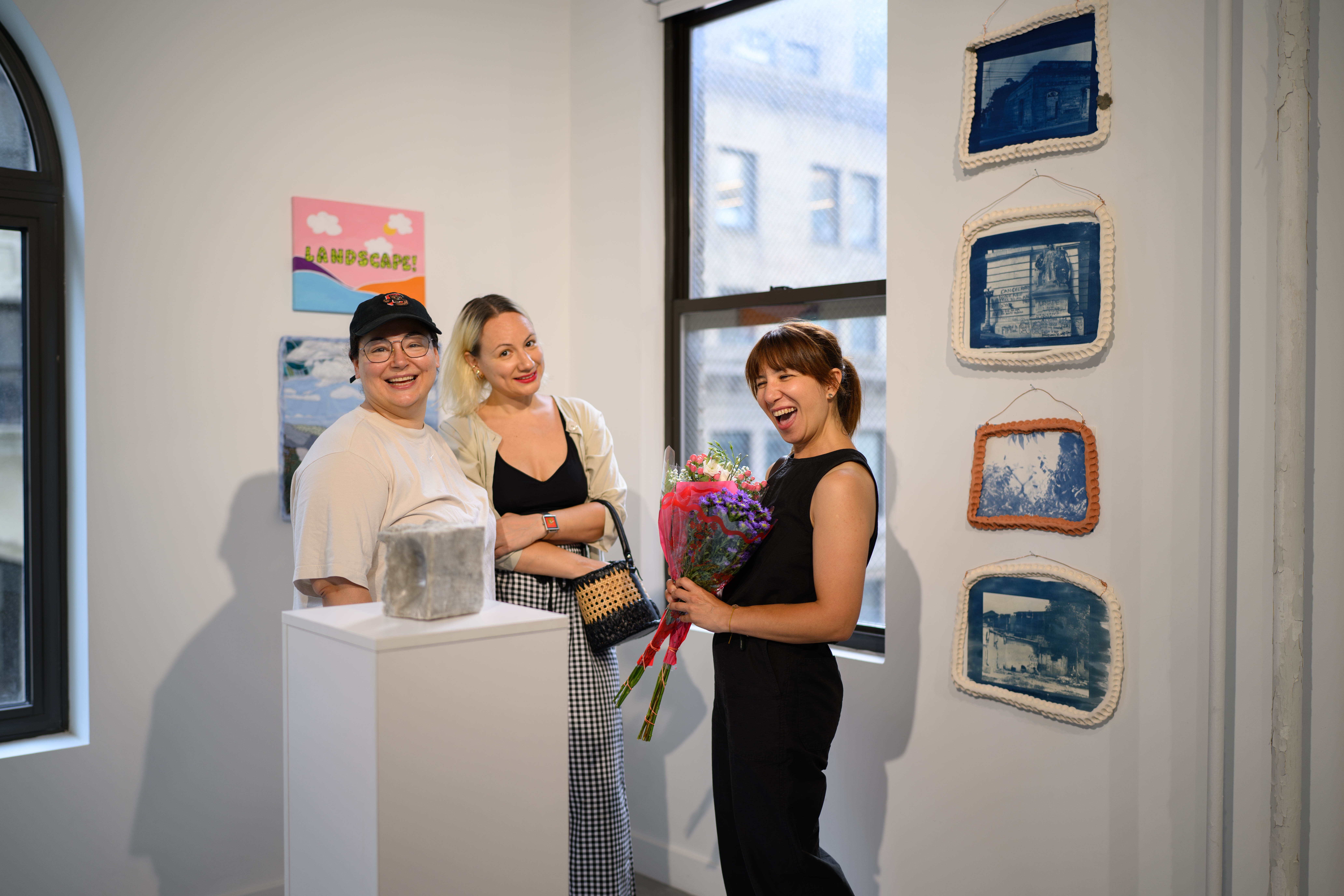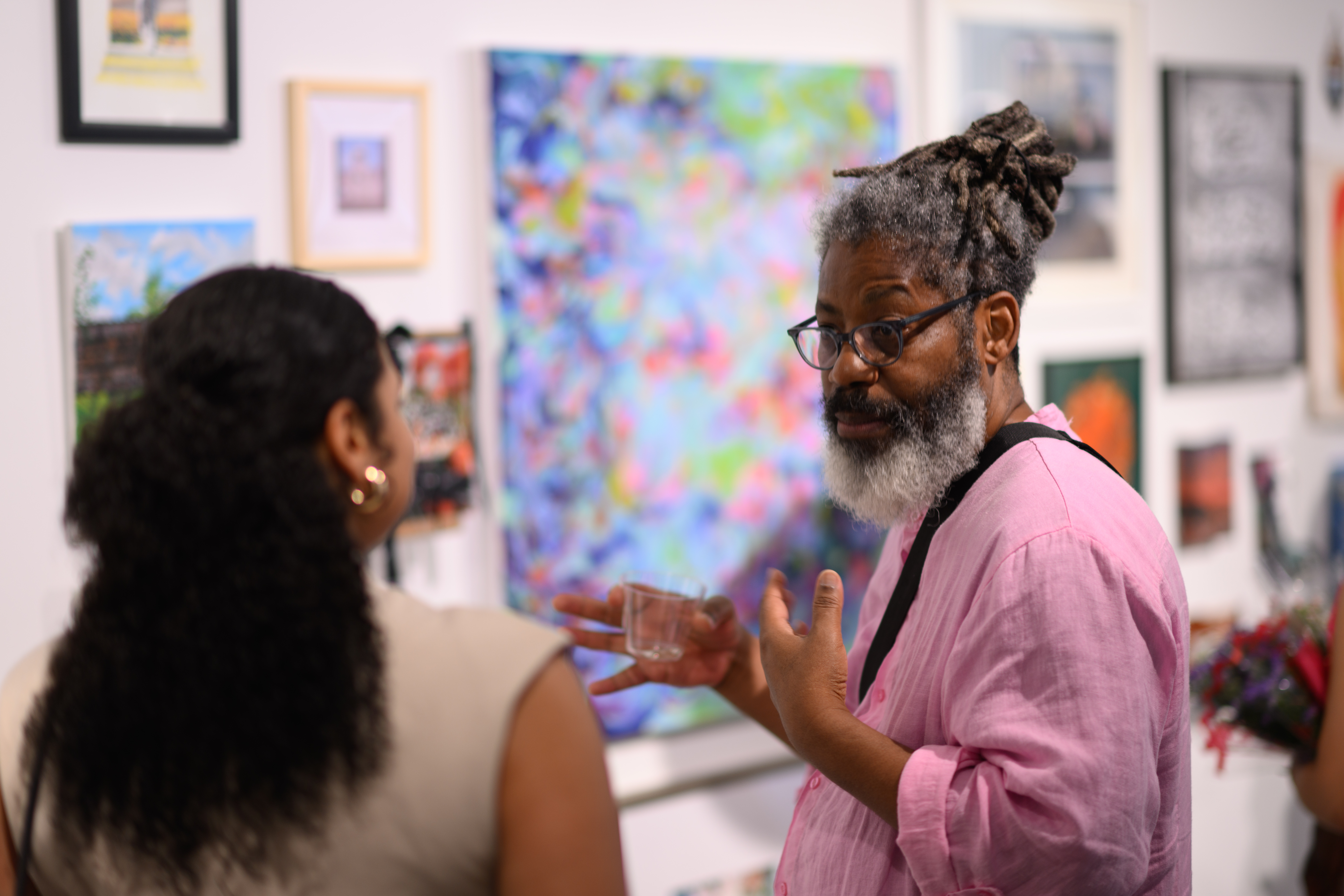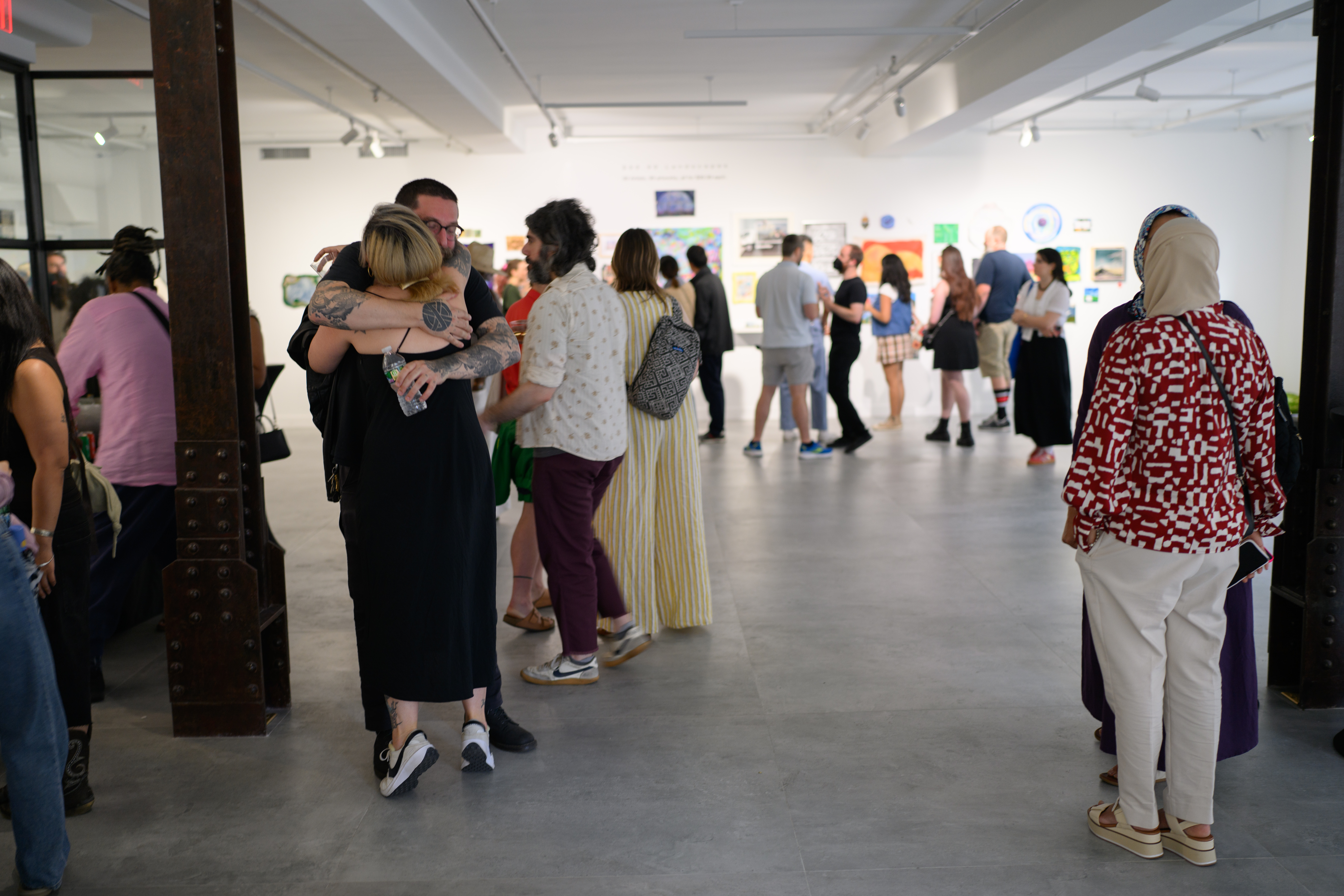
$99.99 (Landscapes) at theBLANC. All photos courtesy of theBLANC.
The $99-Only Art Show
A group show at theblanc explores Current perspectives on art and labor.
By Nana Asase
09.18.2024
It’s Pride weekend, and a Dykes against Genocide march converges with tourists on Fifth Avenue, who stop to pose for selfies with marchers between sightseeing and shopping. Protests are increasingly common around the world as people take to the streets to voice dissatisfaction with their governments’ handlings of political, social, and economic issues. New York City is no exception to these developments.
I walk a few steps down 40th Street to theBLANC Art Space, where a group show called $99.99 (Landscapes) has just opened. Co-curated by artists Blair Simmons and Ariel Oakley, the show encourages dialogue between artists and buyers about the value of labor in art. It brings the economics behind art production and acquisition into focus by establishing a temporary marketplace where all works are priced at $99.99 each. This thematic approach feels particularly relevant now, when all societal systems face questioning and re-examination.
The pandemic ushered in an era of political instability and economic volatility that has culminated in cost-of-living increases, stagnating wages, and growing income inequality. Culture workers have not escaped additional pressures caused by these recent developments, even as their work has been historically undervalued. Reflecting on the strong ties within artistic communities, I wonder why more movements advocating for better labor conditions have failed to emerge and transform the sector in recent years.
$99.99 (Landscapes) addresses this context by featuring both established and emerging artists offering diverse interpretations of its theme side by side. When Simmons and Oakley issued an open call, their goal was to promote inclusivity and expand access within their artistic networks, which include artists and educators from across the country. They wanted to feature up to 99 artists in the show. This inclusive approach, paired with a non-traditional pricing model that values all works equally, challenges the art market's usual emphasis on fame and experience. Buyers and collectors also welcomed this transparent pricing strategy. It simplifies and demystifies an opaque transaction system that typically relies on their relationships with dealers to acquire art. The show also makes apparent that artists are offering creative solutions to a community that has largely moved into the intangible realm of the internet and increasingly feels disaggregated.

$99.99 (Landscapes) at theBLANC.
Howard el-Yasin, an interdisciplinary visual artist, educator, and curator, is fully tuned into the protest movement, and this theme of solidarity appears in his installation Let Them Eat Watermelon. Nine watermelons arranged in a gallery corner create a landscape reminiscent of Félix González-Torres’s minimalist works. Similar to González-Torres, who used ready-mades to advance societal discourse on AIDS—specifically how the inaction of lawmakers and politicians amounted to a moral failure that claimed the lives of many—el-Yasin employs an assemblage of watermelons as a proxy to draw attention to contemporaneous issues of morality relating to war and genocide.
European colonizers and enslaved people brought watermelon to the Americas during the Transatlantic Slave Trade, with the latter group bringing the knowledge of how to grow them. The fruit later became a symbol of self-sufficiency for emancipated slaves in the United States, who grew it to generate income, before it turned into a racist trope. Originating in Africa and domesticated over centuries across the United States and the Middle East, the watermelon becomes a means for el-Yasin to connect African American and Palestinian liberation movements. He invites the current moment into the gallery with the watermelon, which has become synonymous with the Palestinian liberation movement, reminding the community that has gathered here of its porousness as people engage in a lively exchange of ideas and commodities. The nearby protests on Fifth Avenue are not as distant as they might seem.
This deceptively simple work also addresses the theme of labor and challenges the idea that artists create in isolation. El-Yasin seeks to thematize the workers involved in artmaking who are often overlooked. In the case of Let Them Eat Watermelon, this includes everyone from the farm workers who planted, harvested, and transported the watermelons to the gallery assistants who assembled them, as well as el-Yasin’s own contribution of conceptualizing and executing the work. Viewers typically see only the finished product and remain unaware of the labor behind it, and buyers often assess price and value without considering fair compensation for this hidden work. El-Yasin believes that art's true value lies in making people contemplate these factors. The cost of producing Let Them Eat Watermelon is higher than the price the buyer pays. The work also highlights an often-downplayed truth: in a market that undervalues labor, someone inevitably loses out.
Aneesa Julmice, a recent NYU Tisch School of the Arts graduate, applied to $99.99 (Landscapes) through the open call and was invited to show That’s a Liability. She describes the work, which took 50 hours to complete, as an investigation of “the art market and the nuances of art valuation.” Julmice’s digital landscape painting depicts a young Black girl climbing on top of a truck, presumably intrigued by or in search of the image of a playground depicted on its side. While initially humorous, the work leverages a deeper critique against an art market that inflates Black art and labor for short-term profit. Whether this is accomplished through auction speculation or acquisitions by prestigious institutions trying to correct the exclusionary and racist missteps of their pasts, Julmice argues the outcome is the same: Black pain and struggle become commodified "for all the wrong reasons." These practices harm Black artists by distorting their work's value and forcing them to manage unstable markets. They also complicate artists' relationships with new buyers whose motives may be unclear. Here, too, the artist appears to lose out.
“I'd rather make a piece I'm proud of than work that represents only two to three hours of labor," artist Grace Linderholm said when asked about the amount of time spent on her plastic sculpture, Untitled. The piece features a landscape printed on cloth, molded into an organic spherical shape, and inlaid within the sculpture. Linderholm doesn't expect to recover the actual labor and material cost that went into the work from the $99.99 price tag. Like many of her counterparts in the show, Linderholm is both an artist and educator, primarily earning her living outside the cultural sector as a harm reduction specialist. Doing this work has allowed her to maintain an artistic practice.
In recent years, Linderholm has shifted to creating smaller works to reduce the rising cost of storage in New York City—a significant expense for a painter who traditionally works on a large scale. She also expressed concern about the outsized emphasis on marketing in the art world these days, feeling that it's now valued as much as the work itself. This trend has somewhat dampened her enthusiasm to sell the work she produces. Nevertheless, she admits that she missed participating in shows, and that connecting with other artists for this exhibition has brought her joy. The curatorial prompt injected a dose of playfulness into her practice, encouraging her to experiment.

$99.99 (Landscapes) at theBLANC.
Karen Middleton, an MFA student at Maryland Institute College of Art (MICA), submitted her work for the show after learning about the open call from the curators. A military veteran, Middleton found support in the quilting community upon returning from her Afghanistan deployment. Having experienced a similar welcoming atmosphere in her MICA curatorial program, she felt encouraged to participate in her first show in New York. Her piece Misty Mountains is a simplified version of her intricate quilts. Using recycled fabrics from garments and reclaimed materials, she set out to create work valued below the $99.99 price tag by choosing a simple mountain motif and employing a quilting technique that would require minimal hours of manual labor. Middleton’s strategic approach, which positions the artist as key to determining the value of the work, takes on the issue of devalued labor directly. She is deliberate in deciding how many resources she invests in the production of the work, whether that’s labor or material.
While describing her process, Middleton paused briefly to watch Avery Teano, the curatorial assistant, place a red and white "SOLD" sticker next to her quilted piece. Her expression shifted from pure disbelief to excitement. She exclaimed, "Oh shit, I've never sold a piece before!"
Stay updated on future exhibitions at theBLANC here.
